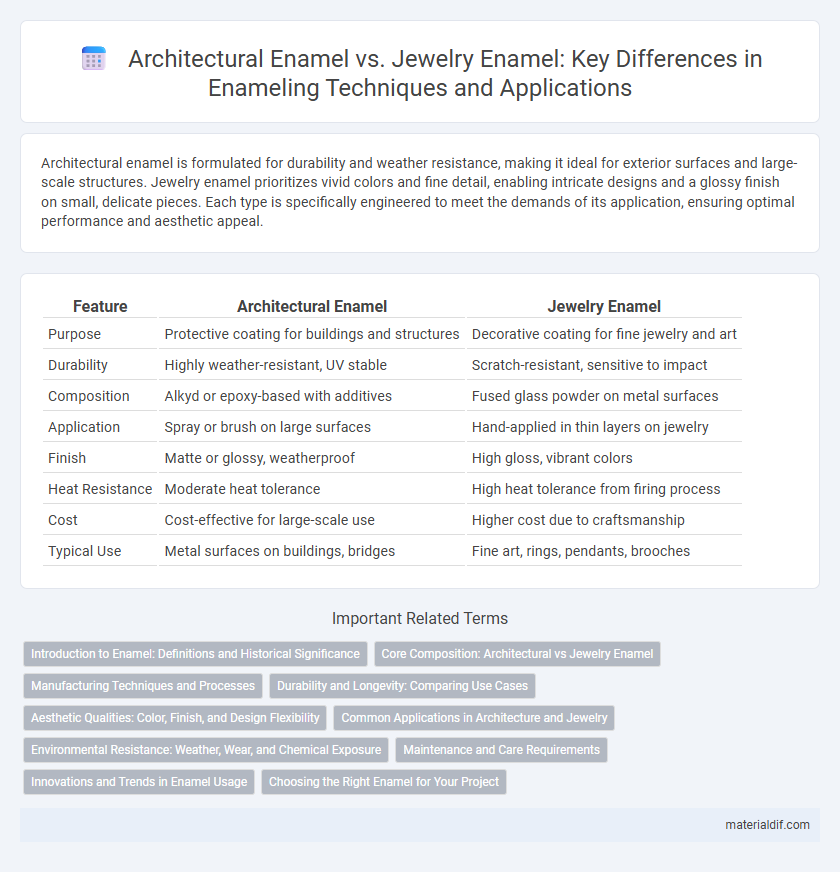Architectural enamel is formulated for durability and weather resistance, making it ideal for exterior surfaces and large-scale structures. Jewelry enamel prioritizes vivid colors and fine detail, enabling intricate designs and a glossy finish on small, delicate pieces. Each type is specifically engineered to meet the demands of its application, ensuring optimal performance and aesthetic appeal.
Table of Comparison
| Feature | Architectural Enamel | Jewelry Enamel |
|---|---|---|
| Purpose | Protective coating for buildings and structures | Decorative coating for fine jewelry and art |
| Durability | Highly weather-resistant, UV stable | Scratch-resistant, sensitive to impact |
| Composition | Alkyd or epoxy-based with additives | Fused glass powder on metal surfaces |
| Application | Spray or brush on large surfaces | Hand-applied in thin layers on jewelry |
| Finish | Matte or glossy, weatherproof | High gloss, vibrant colors |
| Heat Resistance | Moderate heat tolerance | High heat tolerance from firing process |
| Cost | Cost-effective for large-scale use | Higher cost due to craftsmanship |
| Typical Use | Metal surfaces on buildings, bridges | Fine art, rings, pendants, brooches |
Introduction to Enamel: Definitions and Historical Significance
Enamel is a vitreous, glass-like coating fused onto metal surfaces through high-temperature firing, historically employed for both architectural and jewelry applications. Architectural enamel typically features thicker, more durable coatings designed for weather resistance and large-scale surfaces, while jewelry enamel emphasizes intricate, colorful, and delicate designs for personal adornment. Originating in ancient civilizations such as the Egyptians and Byzantines, enamel art reflects cultural significance by combining functionality with ornamental beauty across diverse historical periods.
Core Composition: Architectural vs Jewelry Enamel
Architectural enamel primarily consists of durable alkyd or epoxy resins combined with pigments and fillers to withstand environmental exposure and mechanical wear. Jewelry enamel, often made from finely ground glass powder fused at high temperatures, prioritizes translucency and vibrant color retention on delicate metal surfaces. The core composition of architectural enamel emphasizes weather resistance and adhesion, whereas jewelry enamel focuses on aesthetic brilliance and precision detail.
Manufacturing Techniques and Processes
Architectural enamel involves large-scale application methods such as coating or spray enamel over metal panels, employing curing processes suited for durable, weather-resistant finishes on exterior surfaces. Jewelry enamel manufacturing relies on precise, hand-applied techniques like cloisonne, champleve, or basse-taille, followed by multiple kiln firings at controlled temperatures to achieve intricate designs and vibrant colors. The difference in scale and temperature control highlights the contrast in production, with architectural enamel focusing on protective efficiency and jewelry enamel emphasizing artistic detail.
Durability and Longevity: Comparing Use Cases
Architectural enamel coatings offer superior durability designed for external surfaces, resisting weathering, corrosion, and UV exposure to maintain longevity in harsh environmental conditions. Jewelry enamel, while visually intricate and chemically stable, prioritizes aesthetic detail over extreme wear resistance, making it ideal for decorative, low-impact uses. Selecting enamel depends on the functional requirements: architectural enamel excels in protective performance for buildings, whereas jewelry enamel specializes in fine, durable artistry for personal adornment.
Aesthetic Qualities: Color, Finish, and Design Flexibility
Architectural enamel features durable coatings with smooth, glossy finishes that enhance color vibrancy and weather resistance, ideal for large-scale applications and uniform aesthetics. Jewelry enamel offers intricate design flexibility with rich, translucent colors and varied textures, allowing for detailed artistic expression and unique surface effects. Both types optimize color retention, but architectural enamel prioritizes longevity and uniformity, while jewelry enamel emphasizes fine detail and personalized design complexity.
Common Applications in Architecture and Jewelry
Architectural enamel is commonly applied to metal panels, doors, and facades, providing durable, weather-resistant finishes that enhance building aesthetics and longevity. Jewelry enamel is typically used for intricate decoration on rings, pendants, and brooches, allowing for vibrant colors and detailed designs through techniques like cloisonne and champleve. Both utilize enamel's glassy surface for protection, but architectural enamel prioritizes resistance and scalability, whereas jewelry enamel emphasizes artistic expression and fine detailing.
Environmental Resistance: Weather, Wear, and Chemical Exposure
Architectural enamel is formulated to withstand harsh weather conditions, UV radiation, and chemical pollutants, ensuring long-lasting durability on exterior surfaces. Jewelry enamel prioritizes resistance to wear and abrasion, maintaining its luster and color despite frequent handling and exposure to body oils, though it may be more sensitive to harsh chemicals. Both types incorporate specialized compounds for environmental resistance, but architectural enamels emphasize outdoor durability while jewelry enamels focus on preserving aesthetic qualities under everyday use.
Maintenance and Care Requirements
Architectural enamel coatings demand routine cleaning with mild detergents and occasional touch-ups to resist weathering and UV exposure, ensuring long-term durability on building exteriors. Jewelry enamel requires delicate handling, avoiding harsh chemicals and ultrasonic cleaners to prevent chipping and discoloration, with periodic professional inspections recommended for longevity. Both types benefit from controlled environments, but jewelry enamel necessitates more careful storage to preserve its intricate decorative quality.
Innovations and Trends in Enamel Usage
Architectural enamel innovations emphasize durability and weather resistance, integrating nanotechnology for enhanced UV protection and self-cleaning surfaces. Jewelry enamel trends prioritize vibrant, translucent colors and mixed media techniques, incorporating 3D printing to create intricate designs and lightweight structures. Both sectors increasingly adopt eco-friendly materials and processes, reflecting sustainability concerns while pushing the boundaries of aesthetic and functional enamel applications.
Choosing the Right Enamel for Your Project
Architectural enamel is formulated for durability and weather resistance, making it ideal for exterior surfaces and structural elements, while jewelry enamel emphasizes color vibrancy and precision for intricate decorative applications. Selecting the right enamel depends on factors such as exposure to environmental conditions, desired finish quality, and the substrate material. Understanding these differences ensures optimal adhesion, longevity, and aesthetic appeal tailored to your specific project requirements.
Architectural Enamel vs Jewelry Enamel Infographic

 materialdif.com
materialdif.com